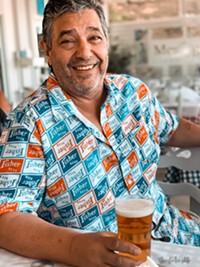Mayor Rocky Anderson has a propensity to use extreme adjectives. People want the reassurance that we live in a “great” city, that we have “fantastic” opportunities for the future or that his dog Sebastian is “super” with kids. Sometimes though, his zeal exposes him to affronts from his detractors. For example, last week he announced plans to use the center lanes along 300 South in downtown for additional parking stalls. He called the initiative “absolutely essential” to the revitalization of Salt Lake City. Faster than you can say “angle parking,” the Tribune wrote an editorial chastening the mayor for sending mixed signals about mass transit. How, they asked, can the mayor who loves buses and TRAX and who hates the Legacy Highway, support the creation of more parking stalls?
Fair question? The mayor could have avoided the seeming compromise by simply choosing his words more carefully. If I were writing his announcement, I would have said, “Salt Lake City is blessed with wide streets and this opportunity to provide additional access for our visitors. This wondrous day is further testament to the wisdom and vision of our pioneer city founders.” Then I would have walked into Squatter’s and bought the house a round of pale ale—from the profits that those stalls are going to yield the city.
Growing up as I did in Bingham Canyon, I never learned how to use adjectives except when swearing, as in “total (insert F-word) (insert A-word)” so it would have been difficult for me to overstate Salt Lake’s addition of a mere 150 stalls—less than 1% of the amount that already exists. I never knew what a parking lot was, either. Bingham’s only street was about 3 lively miles long and no one ever complained about parking. In hodgepodge Salt Lake, though, you may need to park two or three times for one night’s worth of entertainment—think Club Splash, Jazz game and then back again. Until Salt Lake City rebuilds its “nightlife” infrastructure, it’s the fate of visitors to walk or ride great distances. Big hassle, fewer visitors.
Parking isn’t difficult. During the Olympics, people parked easily all over downtown. As I write this, I can see at least 20 unused parking meters along a short stretch of 400 South. Behind our office are another 50 to 100 unused stalls in just three of Salt Lake’s plethora of parking lots. And there’s the rub.
Our time-confused, street-metered parking is policed to no end, with tickets costing a $10 dollar fine for starters. Worse are the parking lots. They’re merely shills for the behind-the-scenes collection agencies who report you to finance companies if you don’t pay their ransom—and I’ll bet you’ve gotten tickets even though you’ve paid for parking. Portland put a moratorium on new parking lots and watched its downtown blossom. Salt Lake City rewards those robbers, allowing them to tear down buildings and tenements as accommodation. Thus, as they kill the city, they kill it worse.
More by John Saltas
-
Instead of a Statue of Responsibility, Utah could build a statue of shame depicting Mike Lee.
Private Eye
- Apr 17, 2024
-
Utah's Statue of Responsibility invites high-brow thinking, and a few low-brow jokes.
Private Eye
- Apr 10, 2024
-
John Stockton's entitled to his privacy and his COVID opinions, but not false facts.
Private Eye
- Mar 27, 2024
- More »
Latest in News
Readers also liked…
-
Raise a glass for E.L.T Harrison, architect of the Beerhive building on Main
Small Lake City
- Oct 11, 2023




